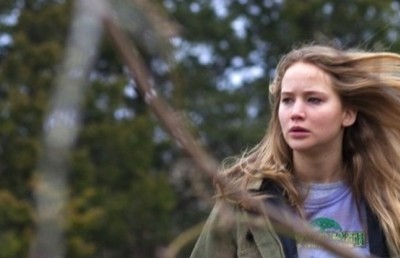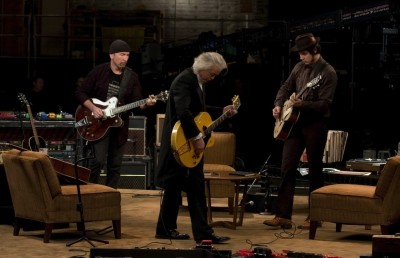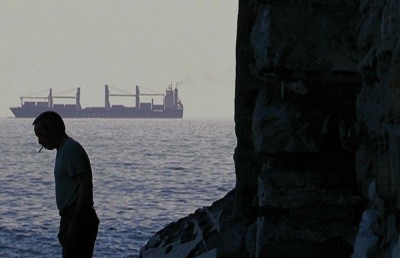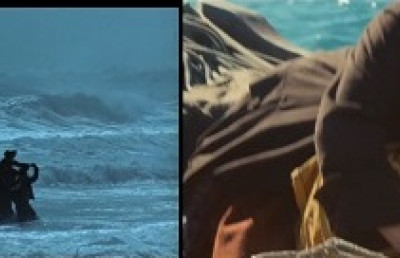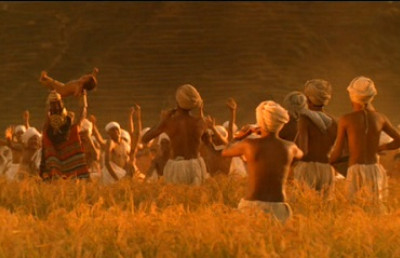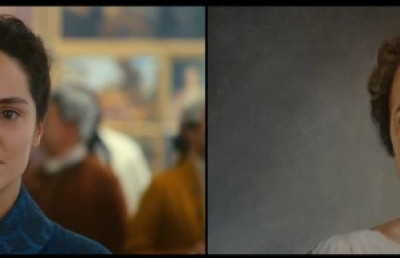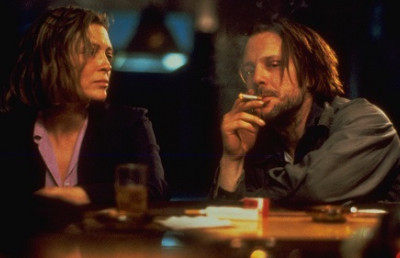Werner Herzog Between Documentary and Fiction
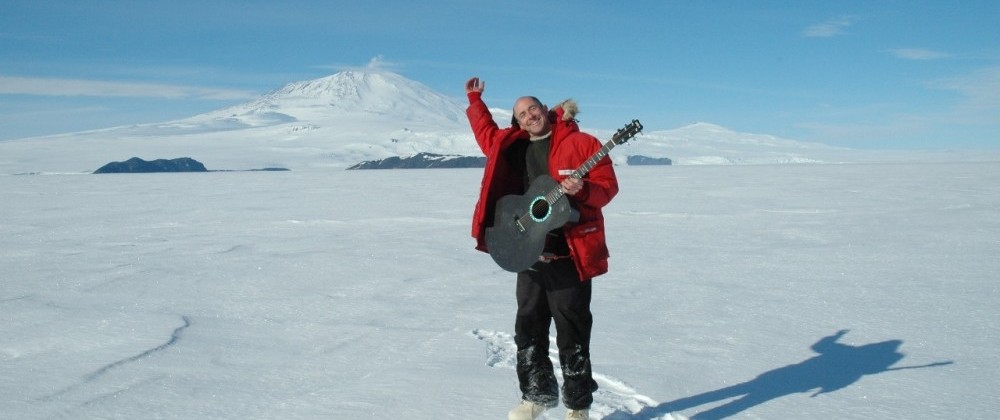
In 1999 Werner Herzog wrote a ‘manifesto,’ the ‘Minnesota Declaration,’ as an attempt to explain his way of filmmaking and his ideas about the truth and purity of the image, in contrast to the cinematic movement widely known as Cinema Verity, and in relation to his film Lessons of Darkness (1992)
1. By dint of declaration the so-called Cinema Verité is devoid of verité. It reaches a merely superficial truth, the truth of accountants.
2. One well-known representative of Cinema Verité declared publicly that truth can be easily found by taking a camera and trying to be honest. He resembles the night watchman at the Supreme Court who resents the amount of written law and legal procedures. “For me,” he says, “there should be only one single law: the bad guys should go to jail.”
Unfortunately, he is part right, for most of the many, much of the time.
3. Cinema Verité confounds fact and truth, and thus plows only stones. And yet, facts sometimes have a strange and bizarre power that makes their inherent truth seem unbelievable.
4. Fact creates norms, and truth illumination.
5. There are deeper strata of truth in cinema, and there is such a thing as poetic, ecstatic truth. It is mysterious and elusive, and can be reached only through fabrication and imagination and stylization.
6. Filmmakers of Cinema Verité resemble tourists who take pictures amid ancient ruins of facts.
7. Tourism is sin, and travel on foot virtue.
8. Each year at springtime scores of people on snowmobiles crash through the melting ice on the lakes of Minnesota and drown. Pressure is mounting on the new governor to pass a protective law. He, the former wrestler and bodyguard, has the only sage answer to this: “You can’t legislate stupidity.”
9. The gauntlet is hereby thrown down.
10. The moon is dull. Mother Nature doesn’t call, doesn’t speak to you, although a glacier eventually farts. And don’t you listen to the Song of Life.
11. We ought to be grateful that the Universe out there knows no smile.
12. Life in the oceans must be sheer hell. A vast, merciless hell of permanent and immediate danger. So much of a hell that during evolution some species – including man – crawled, fled onto some small continents of solid land, where the Lessons of Darkness continue. (Werner Herzog, Walker Art Center, Minneapolis, Minnesota, 1999)
Born in Munich on September 5, 1942, Werner Herzog is one of the most independent and prolific filmmakers in the history of cinema – in fact, his filmography to date counts more than fifty titles, many of which he produced with his own company, Herzog Filmproduktion. Herzog is the author of a large number of both fiction films and documentaries; on the latter, Van Wert writes: “At first glance eclectic, obsessive and renegade the documentaries of Werner Herzog do, finally and inevitably, fit into the elaborate intertextual fabric of his fiction films” (51). His first documentaries immediately encountered problems of distribution, usually on account of the unusual and unmarketable topic of the film, or for the lengthy running times; these issues excluded Herzog from the normal circuits of distribution, but made his works perfect for film festivals and for television (Van Wert 51). His vast production of non-fiction films has always been developed in parallel with the fiction production. A good example of this assertion is that, in 1976, he produced an important feature film such as Heart of Glass and, at the same time, three documentaries: How Much Wood Would a Woodchuck Chuck, No One Will Play With Me, and La Soufrière.
When analysing his production, it becomes clear that any attempt to make a canonical distinction between fiction and non-fiction is completely inadequate; this is because a mixture and combination of these two forms is always present in his films, in the effort to reach what Herzog himself calls an “ecstatic truth” (Herzog, “Herzog on Herzog” 238). This can be explained as a truth that breaks all our usual mental schemes in order to rise to a poetic level – to use the director’s own words – which can be attained only through fabrication, imagination and stylisation.
Even eschewing an in-depth approach to a differentiation between what is considered as real and what is considered as artificial in his cinema, it is still possible to point out that one of the basic and unique elements of Herzog’s approach to filmmaking is his ability to work using non binding and not very detailed screenplays. The majority of Herzog’s films have been shot without storyboard, and have thus been based on an absolute freedom of expression. His actors are always allowed to improvise; indeed, his actors are asked to improvise. Moreover, the majority of the shooting is set and done outdoors, without the limitations and impediments that are typical of a standard film set:
When I write a screenplay I am always conscious that things will change – characters might even be added – once we start shooting, so I will never slavishly fill page after page with lines of dialogue. […] It is important to allow real life and real images to fill up the film at a later stage. (Herzog, “Herzog on Herzog” 105)
Improvisation is thus linked to an openness to the reality of the set and the actors. When Herzog shoots a film, the entire experience of filmmaking is directly connected to the concreteness of real life; in other terms, the daily life of all those involved in the production becomes part of the movie itself, so that a strong relationship develops between the story of the film and the many stories that are born from and within the crew. This attitude allows the reality of the set to shape the film and, even more, to make the images vibrate with the rhythm of every single human being’s experience. Such ‘vibration’ represents a key concept in non-fiction film analysis, from a semiotic perspective, especially in relation to that operation, known as mise-en-phase, that the spectator must perform in order to take part in the filmic narration. The mise-en-phase is often evident and direct; it seeks to make the spectator “vibrate with the rhythm” (Casetti 256) of the events that are being narrated. In other words, it aims to make the audience participate emotionally and intellectually, within the boundaries of the cinematic experience, with specific strategies such as the use of music, sounds or photography.
In this way, and especially in his fiction films, Herzog opens the door to the unpredictable and to complexity; chance is always there, waiting to contribute in unpredictable ways to the final structure of the narration. This is a process of filmmaking that can not be realised on a traditional indoor set.
Improvisation sometimes comes together with what Herzog calls: audience test, in other words, a sort of test that has to be administered to the audience to see what their reaction will be. Improvisation but, at the same time, the scene that I want to shoot, the instant that I want to frame has to be proposed to the spectator and see what reaction he/she will have in relation to director’s reaction to the same images but, obviously, in a different context. In Fata Morgana (1970) for example, a film that as many others (The Wild Blue Yonder, 2005; The Enigma of Kaspar Hauser, 1974; Pilgrimage, 2001) presents an ‘embarrassed’ (to use Herzog’s term) portrait of our world as exploited by man, nothing was planned. Herzog and his crew shot in the Sahara desert with a very small budget and in very difficult conditions that, for obvious reasons, made the production of this film completely casual. He decided the shootings day by day, but, at the same time, basing everything not on a script but on the idea that “I knew there was something I needed to film in Africa” (Herzog, “Herzog on Herzog” 47) and on the ambition of visually representing what a Fata Morgana (mirage) means.
Herzog believes in going places, and in filming where the action unfolds, without compromises, no matter how difficult the situation. […] Not by a search for greater realism, but by the desire to capture the true ‘spirit’ of the landscapes. (Mazierska & Rascaroli 80)
For these reasons the first scene of this film, eight shots of eight different planes landing on a runway, has been realised as a film-test for the audience:
I had the feeling that audiences who were still watching by the sixth or seventh landing would stay to the end. This opening scene sorts out audiences; it is a kind of test. As day grows hotter and hotter and the air becomes drier and drier, so the images get more and more blurred, more impalpable. (Herzog, “Herzog on Herzog” 49)
In other words: a ‘synthetic’ but also truthful fata morgana. In this essay, I will explore the subtle combination of reality and artifice, of fiction and non-fiction in Herzog’s work. While other critics have looked at this topic by analysing specific films and, often, by applying categories of filmic realism to his work, I will here survey Herzog’s filmmaking methods in an attempt to illuminate his approach to the cinema. My approach will mix a reading of Herzog’s eloquent self-analysis of his methodology to be found in his interviews, and an observation of his techniques in both fiction and non-fiction filmmaking, and their effects.
Physicality: for a corporal cinemaIt is probably the idea of physicality, transported into film practice, that makes Werner Herzog such a unique, idiosyncratic director; since the very beginning of his career (career that started with Herakles, 1962, a short film combining footage of bodybuilders with the accident at Le Mans), he has always identified the art of filmmaking as a real physical exercise. As he has declared in many interviews during the past years, the process of making a film has more in common with athletics than with aesthetics; where with the term athletics he refers to concrete physical workout. In other words, the director’s body during the entire process of production of a film has to sweat, feel the labour, and suffer. Of course the aesthetic component is always fundamental, but what makes a really good film, for Herzog, are the athletic skills of a director. To prove this he asserts: “Many great filmmakers have been astonishingly physical, athletic people. A much higher percentage than writers or musicians” (Herzog, “Herzog on Herzog” 15). In addition to his famous ideas about walking, [1] this concept can be related to what Herzog believed a film school should train future directors in like when he was asked to reflect on the possibility to open one, as other directors of the New German Cinema, such as Edgar Raitz, did.
The New German Cinema was a cinematographic movement that was born around the time of Herzog’s first long feature film, Signs of Life (1968) and started with what is known as the Oberhausen Manifesto. [2] It was basically divided into two main waves: the first one composed by the members of the Manifesto, such as Kluge or Reitz, and a second one with people such as Fassbinder or Wenders. Even if for reasons of age Herzog likes to put himself in the second wave, in many occasions (and again against any kind of categorisation) he has confirmed that:
I did not take part in the manifesto and did not even know they were writing it […] I was never part of the group. Basically, it was a coincidence that I belonged to the first generation of post-war Germans, many of whom attempted to articulate themselves in new ways cinematically, not difficult when we think of German cinema in the 1950s. (Herzog, “Herzog on Herzog” 32)
In this context of physicality and education, Herzog’s way of thinking goes back again to the basic characteristics of the human being; hypothetically, if he had to open a film school (places that in general he does not like), this school would have a boxing ring in the middle, where the students could train, fight and maybe break their nose. In the end, if they will not become filmmakers, they at least will be good athletes:
My film school would allow young people who want to make films to experience a certain climate of excitement of the mind. This is what ultimately creates films and nothing else. It is not technicians that film schools should be producing, but people with a real agitation of mind. People with spirit, with a burning flame within them. (Herzog, “Herzog on Herzog” 16)
Making films that are a combination of fiction and reality, Herzog is well aware that it is impossible to reproduce reality in its totality, ‘the truth’ about things. Even if a strong distinction between his fiction films and his documentaries can still be found, Herzog embodies this dual concept of reality in fiction in all his production. A telling example of this practice is the famous scene of the boat in Fitzcarraldo (1982). In this specific sequence, Herzog wanted to make a ship climb a mountain in order to then reach a river on the other side. In spite of the contrary opinion of the producers, of the difficulties of working in the equatorial jungle, of the fact that he was running out of money and many other issues, Herzog wanted to shoot this scene using the real boat and not a model (as any other director would do). And he did.
To attain the ‘purity of the gaze’ for Herzog is to film what the human eye has never seen before, reaching locations where no other director arrived before or would even imagine to shoot a film, such as: the Amazon Jungle for Fitzcarraldo, the Andes for Aguirre, the Wrath of God (1972) or the Cerro Torre mountain for The Dark Glow of the Mountains (1984). Filmmaking for him means being able to shoot images not yet seen, images full of an intensity that escapes our common perception; at the same time, this intensity is focused on unusual characters (often marginal ones, rejects of our society). The human figure is always central in his work; yet, the human beings that Herzog presents to us are, in a way, not ‘standard’ figures; for instance such ‘madmen’ and ‘losers’ as Aguirre in Aguirre, the Wrath of God or Fitzcarraldo in the film of the same title, the revolutionary dwarfs in Even Dwarfs Started Small (1970), Dorrington in The White Diamond (2004), Treadwell, torn to pieces by his grizzlies in Grizzly Man (2005), or the man lying under a tree while the volcano is ready to explode in La Soufriére (1977) – this man was the only inhabitant who refused to evacuate the island where he lived.
The process of merging fiction and non-fiction may be also seen as a desperate attempt to rescue his images from the everyday, banal reality of our modern industrial civilization. In Aguirre as well as in Fitzcarraldo the film crew built for themselves the rafts necessary for the shootings along rivers, they lived for months in the jungle, far away from any form of civilisation, fighting with diseases and wild animals. Far from the search of a romantic vision of life (one of the most regular accusations moved by critics to Herzog), this method transforms the shooting into a material physical experience, a more corporal than an intellectual one, not only for the director, but for all those involved, actors and technicians. For Herzog, only when we confront our existential limits, can we express to others who we really are (Herzog, “Herzog on Herzog” 19). This experience reflects that of all the protagonists of his films, whether fictional or real: all his anti-heroes have to measure themselves with their physical and mental limits. It is a risky approach to filmmaking, not in terms of the safety for the crew (Herzog insists that he is not mad and he would never endanger people’s lives), but in term of final aesthetic product, as the director renounces control over it. Each Herzog project represents a total risk for the production, and there is always a possibility that the film will never be realised.
For an understanding of the relationship between fiction and non-fiction in Herzog’s work, it is interesting that the director considers his Fitzcarraldo, a fictional film, as his best documentary. As already mentioned, the process of moving the boat from one side to the other of that mountain was for real, and the final version of this shot, which was edited in the film, is full of this trueness. It is not a matter of the ‘reality of fiction,’ but about vision, and the aesthetics of this vision, and always within the context of Herzog’s search for an ecstatic truth.
Pulling a boat of that size over a mountain would inevitably create situations that nobody had foreseen and so would bring life to the film. […] There is a mysterious truth in what we did, and I wanted the audience in a position where they could trust their own eyes. (Herzog, “Herzog on Herzog” 177)
It is impossible to categorise Herzog’s film, as it does not follow any traditional rule, any genre. Take this reflection by Herzog on a genre such as science-fiction, with which he toyed a few times, most notably in Fata Morgana and The Wild Blue Yonder:
The spoken textI think science-fiction films are wonderful because they are pure imagination and that is what cinema is all about. But on the other hand, all of these films hint that what you see is artificially made in a studio with digital effects. This is the issue of truthfulness in today’s cinema. It is not about realism or naturalism. I am speaking of something different. (Herzog, “Herzog on Herzog” 177)
In addition to the above-described elements of Herzog’s cinematography, a further key concept has to be mentioned and analysed: that of language and communication. It seems that languages are a real obsession for Herzog. In most of his interviews there is an allusion to communication between people, to languages and, in particular, to the fact that the variety and multiplicity of the languages of the world is declining. One of Herzog’s future plans is to make a film on the idea of the disappearance of languages.
A film that delves into the topic of human language is Land of Silence and Darkness (1971). This film is not only a documentary about the origins of languages and on language disabilities, it is also a broad reflection on communication in general. Language in this film is presented as a tool that puts different human beings in contact, a tool that sometimes, however, presents problems: what are the techniques activated by a deaf person to establish a communicative relationship? A double but related idea: the absence of language and languages that disappear; idioms are by nature instable and fragile, soaked in that fragility that characterise many of Herzog’s films, such as Stroszek (1976), Woyzeck (1979), Kaspar Hauser (1974) or ??God’s Angry Man ?? (1980).
People outside the rules are often Herzog’s protagonists; in Land of Silence and Darkness, characters that are blind and deaf accompany the spectator in a communicative journey through the existence of human beings like Fini Straubinger, who relates herself to the world only by the sense of touch. A different way to converse, often in total darkness; a condition that in some occasions, like in Lessons of Darkness (1982), transforms the film camera into a subject, itself moving between other subjects, a strategy realised with a deliberate dynamicity, with hand-held camera, without the use of a tripod or of zooms, or any other type of non-human movement. In terms of ‘spoken text,’ profitable is the adoption of some of the categories identified by William Van Wert in his book The Films of Werner Herzog:
1-Silence. It is important to note that Herzog seems to have a devotee’s loyality to characters whose speech has been lost, interrupted, arrested, or wilfully discarded. He resists calling them extreme characters or marginal beings. Instead, he refers to them as pure beings, and includes himself in their company.
2-Dialect. Herzog shares with Godard a fascination with the way languages are spoken by non-native speakers and the permutations on pronunciation in any given language system. […] Herzog is interested in these pure forms of speech and does not consider them bastardizations. (Precautions Against Fanatics, Kaspar Hauser, Woodchuck). (55)
It is clear once again from this description that Herzog’s non-fictions can not be considered as ‘pure’ documentaries; his documentaries famously include as much staged and scripted material as ‘real’ footage (as in Fata Morgana, The Wild Blue Yonder, La Soufrière), and indeed overtly deal with the dichotomy fact/truth and with the question of how such truth can be communicated to the spectator through the language of cinema.
What can be considered as a typical element of his documentary style is the voiceover narration (always through Herzog’s own voice, usually speaking in English), [3] which expresses the filmmaker’s personal meditation and point of view on the film’s images (this is extremely clear, for instance, in Land of Silence and Darkness). Herzog has always wanted to use his own voice, with his unmasked German accent, both in the films and outside: he takes an active role in all the interviews, without resorting to a translator, and instead of using a professional voiceover reader, he prefers to get directly in touch with his audience. This strategy produces a powerful sense of truth and intimacy (not devoid of a touch of narcissism, which could interestingly be analysed in terms of authorship and auterism). As Herzog himself comments:
In my ‘documentaries’ you will often hear my voice. One reason for this is that I would rather audiences who do not understand German listen to my voice in English rather than hear me in German and read the subtitles. I think the result is a stronger connection to what I originally intended for the film. I have also never liked the polished and inflected voices of those overly trained actors. (Herzog, “Herzg on Herzog” 54).
In Herzog’s documentaries, the focus is on the character and, often, on his or her suffering; it is not only simple representation, but the search for a purity that can destroy cultural, social, moral barriers and reach a more authentic, ‘raw’ human expression, even through a forthright identification between director and characters (as in Little Dieter Needs to Fly, 1997 and Grizzly Man).
To conclude, I would like to briefly focus my attention on Herzog’s latest documentary, which usefully represents a sort of summary of many elements of his cinematic style: Encounters at the End of the World (2008). In this film, the director explores the Antarctic area through an unusual poetic and ethnographic approach; an approach that overtly refers to but also breaks with the scheme of a traditional wildlife documentary. The context in which this film has been produced induces the spectator to take up well-defined and predictable expectations before viewing it, such as: images of nature, wildlife, animals, ice. These expectations are induced by the audience’s familiarity with years of wildlife documentary production for television, as well as by recent box office hits such as March of the Penguins (2005).
However, from the very beginning, from the first scenes located in McMurdo Bay, an American settlement, we feel that something ‘looks wrong’. The film in fact, unexpectedly concentrates more on the people living and working in the Antarctic, and on the reasons that make a person choose this particular style of life. Encounters at the End of the World claims to be an anthropological film which directly addresses its viewer through a strong communicative strategy, such as voiceover; voiceover that, also in this case, has the director’s distinctive German accent.
Possibly in contrast with the producers’ desire for a film full of wildlife images, the German director brings to light a series of interesting stories of people operating in that desolate land. Nature is, however, always there with its vastness and force; and the people who have chosen to leave their normal lives behind in order to be at the end of the world are exactly like Treadwell or Aguirre – anti-heroes isolated from the rest of the society, who entertain a controversial relationship with nature itself. Among them are a banker turned truck driver, a plumber claiming to be a direct descendent of the Aztecs, and a computer expert who contorts her body to fit into a piece of carry-on luggage.
The subject of languages emerges also in this film, through the figures of an ex-academic, a linguist who runs a greenhouse, and who now lives in a land without languages, and of a taciturn penguin researcher, who spends his entire life fully immersed in the penguin world, and is no longer used to communicating with human beings as can be evinced by his monosyllabic responses to Herzog’s questions. Not a naturalistic documentary then, but a complex movie that moves, as often happens in Herzog’s work, through an unexplored and mysteriously new stylistic direction.
In Herzog’s film, the space represented is at the same level as the space of the spectator; the spectator is placed directly inside the fragile boundaries of the cinematic text. The diegetic process identifies a figure of the spectator that interacts with the elements of the text itself, building a context as space of action and communication. We, the audience, are an integral part of the film, not simple voyeurs that watch the events from the outside. The director positions himself inside the textual space as mere spectator, at the same level of the audience. As author, he addresses us directly. Camera movements are characterised by a strong dynamicity (for obvious reasons, common in wildlife documentaries) during the scenes in the field, and are very static during the frequent interviews.
What physically ‘inserts’ us in the text are some of the elements inscribed in the film itself; an example occurs during the ‘survival school’ scene, which that every person must attend before being allowed to go into the field. We are inside an igloo. Two people are removing snow in order to create more room inside the igloo, and suddenly one of the two men throws the snow directly at the camera, and says: “Oh god…sorry”
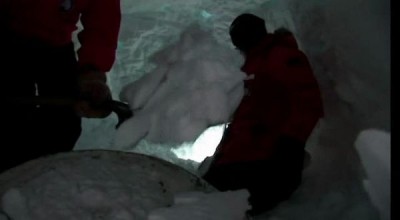
In an other scene, we can see some people performing an exercise, the instructor is far from them, and the camera is with him. Suddenly and rapidly he turns and directly addresses the camera, explaining the aim of the exercise to us. These are instances of people directing their gazes to the camera, thus “interpellating directly the spectator” (Casetti, “Inside the gaze” 9).
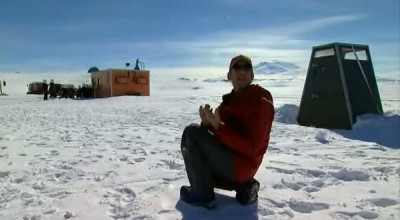
Herzog, thus, is a non-canonical director who works with a specific and extraordinarily consistent visionary approach. This approach clearly moves beyond pictorialism, or the pure and classical aesthetic of the image, and impels Herzog to investigate the connection between nature and human beings; even if, most of the time, his films make us deal with dilated times and absurd spaces (The Wild Blue Yonder), with a nature that gives a rhythm to our existence and frees us from the limitations of the common human thought.
I’ll leave you with Herzog’s own words in relation to his well-known ‘no-night dreams’ problem:
Every morning upon waking I always feel something of a deficit. ‘Again! Why have I not dreamt?’ I feel like people who do not eat or sleep enough, who are always hungry or tired, and this might be one of the reasons why I make films. Maybe I want to create images for the screen that are so obviously absent from my head at night. I am constantly daydreaming, however. (Herzog, “Herzog on Herzog” 61)
Endnotes
1 Walking for Werner Herzog is one of the most important activities for all human beings. Legendary is his walk from Germany to Paris to visit his friend and mentor Lotte Eisner, after notification of her possible fatal illness in 1974. Herzog was completely convinced that this long walk would have helped Lotte to recover: “Believing that she would stay alive if I came on foot”. (Herzog, “Walking on Ice” 5)
2 The Oberhausen Manifesto was signed by two dozen German filmmakers on 28 February 1962 at the Oberhausen Short Film Festival. It was an attempt by young German filmmakers to combat the post-war domination of their country’s film markets by the United States, something that meant indigenous film production was being steadily decimated. (Herzog, “Herzog on Herzog” 30)
3 In Fata Morgana, Herzog still speaks in German, but he turned to English after that film.
Bibliography
Casetti, Francesco. Inside the Gaze: The Film and Its Spectator. Bloomington and Indianapolis: Indiana University Press, 1999.
—-. Theories of Cinema 1945 – 1995. Austin: University of Texas Press, 1999.
Herzog, Werner. Herzog on Herzog. Ed. Cronin, Paul. London and New York: Faber and Faber, 2002.
—-. Walking on ice. New York: Tanam, 1980.
Rascaroli Laura, Ewa Mazierska. Crossing New Europe: Postmodern Travel and The European Road Movie. London: Wallflower, 2006.
Van Wert, William. “Last Words: observations on a new language”. The Films of Werner Herzog. Ed. Corrigan, Timothy. London and New York: Methuen, 1986.


